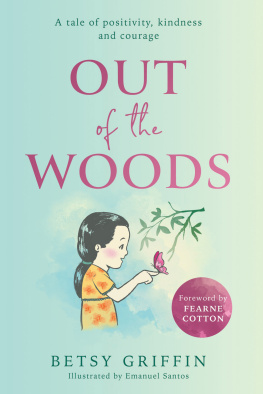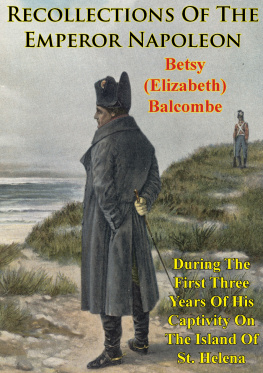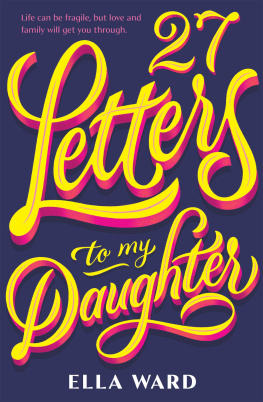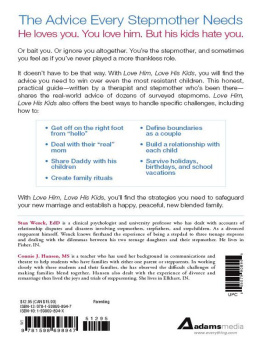

Copyright 2017 by Betsy Fasbinder
All rights reserved. No part of this publication may be reproduced, distributed, or transmitted in any form or by any means, including photocopying, recording, digital scanning, or other electronic or mechanical methods, without the prior written permission of the publisher, except in the case of brief quotations embodied in critical reviews and certain other noncommercial uses permitted by copyright law. For permission requests, please address She Writes Press.
Published 2017
Printed in the United States of America
Print ISBN: 978-1-63152-198-0
E-ISBN: 978-1-63152-199-7
Library of Congress Control Number: 2016959225
For information, address:
She Writes Press
1563 Solano Ave #546
Berkeley, CA 94707
Cover design Julie Metz, Ltd./metzdesign.com
Interior design by Tabitha Lahr
She Writes Press is a division of SparkPoint Studio, LLC.
Names and identifying characteristics have been changed to protect the privacy of certain individuals.
In memory of Janet Lundgren Fasbinder,
to whom I owe three lifetimes of
gratitude for my beautiful inherited life.
And in the end we were all just humans,
drunk on the idea that love,
only love, could heal our brokenness.
F. Scott Fitzgerald
No Answers on The Shelves
* a prologue *
W hen I was about to be a mother for the first time, I did what lots of expectant moms do; I went to the bookstore to try to prepare myself. My fingers perused the spines of the books on the shelf: The Best Baby Name Book, and What to Expect When Youre Expecting and dozens more. But I wasnt pregnant. I was expecting nothing like what those books described. I was about to become a parent, not by giving birth, but by marrying a man with a six-and-a-half-year-old son. So I looked to another shelf, with books all about stepparenting. I cracked open book after book and found tables of contents that had no connection to what I was going through. I saw chapters like Managing the Ex Factor, Two Houses, One Set of Expectations, and Jealous of the Ex?, and topics such as spousal support, child custody battles, lawyers, resentment, conflict, and guilt. While the pregnancy and baby books didnt describe what I was facing, neither did the books on being a stepparent.
My husband-to-be had not divorced his young wife; she had died. Leukemia took Janet Lundgren Fasbinder when she was a young mother of a five-year-old. Tom was a widower at forty. And Max, their son, had lost his mother. I wasnt stepping into conflict or court battles, custody hassles, or disputed alimony payments. I was joining a family that had suffered a tragic loss.
Daunted by the prospect of facing motherhood under such unusual circumstances, I found no comfort or information on the shelves. It wasnt just the absence of self-help books relevant to my circumstances that got to me that day in the bookstore. It was the preponderance of negative images of stepmothers. Most every fairy tale I could recall and nearly every Disney movie featured an orphan of some sort, a vulnerable character whose parent, or parents, had died. Stepparents dont get very high marks in fairy tales. Theyre neglectful, abusive, cruel, unloving. The stepmother is an evil archetype, a much-used trope of a villain. I could find no model on the shelves for the kind of mother I wanted to be, and no instructions for how to deal with the presence of grief in our family rather than the conflict of divorce.
During the time I became Toms wife and Maxs second mother, I did what I always do to try to understand my circumstances: I wrote. I didnt find stories describing my life, providing guidance, so I wrote them. I wrote in my journal. I wrote short essays and poems. I ranted, I whined, I questioned, all through the flow of ink onto the page. And like all of the writing I did at that time, I never intended to share any of it with anyone. Writing, at that point in my life, was a private endeavor. I wrote to understand, to gain perspective, to sort things out, to express the things I couldnt find a way to say aloud. My writing helped me step back and approach mothering more thoughtfully. It let me have a private space to confess my fears and my confusions, to air my petty yearnings along with my heartbreaks without spilling them onto Tom and Max. They had enough to deal with. The stories sat for many years in a file on my computer and in fragments in various journals.
More than a dozen years after I wrote the first stories, I read one of them aloud at a writers salon. It was spring, and the theme of the salon was mothering. To me it was a simple little story of that moment when I began to feel motherly love for Max. I feared that my humble story would not mean much to anyone who had not been in my precise circumstances. But listeners told me that the story moved them. They told me of their own experiences, which were different than mine, but somehow the themes were the same. I was wrong because of something that Ive always known, but had forgotten. While the exact circumstances of our lives may differ wildly from one anothers, love and loss, triumph and disappointment, desire and discouragement, courage and fear are the themes of everyones stories, and it is those themes which inextricably bind us as humans, one to another.
If this book had been a screenplay, Id have written a directors note to move the camera close for every exchange. This story is not meant to represent the entirety of what life was like for us as we became and endured as a family. Friends and family members looking for themselves in these pages may be disappointed because, but for a small few, the characters in this story all lived in my house.
As I read through journals and stories, looked through photographs, and allowed myself to remember, I was struck by two truths: A lot of really bad stuff happened in order for us to become a family, and a lot of really good stuff happened, too. Despite the tragedy that allowed us to become a family in the first place, much of our shared life has been absent some of the challenges that so many blended families experience. While grief and loss are recurring themes in my marriage and in our shared family experience, weve been fortunate beyond measure to be a close and loving family.
This book is a simple story of a regular family, formed in an irregular way. It is a collection of the ordinary and extraordinary moments inside our family. It is my story of love and loss living side by side in our home, as it does in so many others. It is my story of falling in love with my inherited family.
First Dates and Resolutions
I have my family because of a New Years resolution.
When Tom called to ask me out on our first date, wed known each other for more than sixteen years. A call directly from Tom was unexpected enoughwe usually encountered each other at gatherings at my sisters house. Tom had been college friends at Purdue with my older sister, Dianne, and had been freshman roommates with Jim, who would later become Diannes husband.
Di and Jim were part of what Ive always thought of as The Great Purdue Migration in the mid-seventies. Realizing they were actually free to leave Indiana, theyand a whole group of their friends in the postSummer of Love eraset their sights on the City by the Bay. Tom was part of that migration. Tom, Di, and Jim became housemates in San Francisco.
I met Tom when I was fifteen and he was twenty-five. Tom joined my sister and her husband one Christmas when they drove from San Francisco to Californias Central San Joaquin Valley town of Visalia, to share the holiday with our family.
Next page








